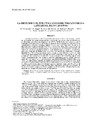Please use this identifier to cite or link to this item:
https://accedacris.ulpgc.es/handle/10553/46265
| Title: | La erupción y el tubo volcánico del volcán corona (Lanzarote, Islas Canarias) | Other Titles: | The eruption and lava tubes of Corona Volcano (Lanzarote, Canary Islands) | Authors: | Carracedo, J. C. Singer, B. Jicha, B. Guillou, H. Rodríguez Badiola, Eduardo Meco, J. Pérez Torrado, F. J. Gimeno, D. Socorro, S. Láinez, A. |
UNESCO Clasification: | 250621 Vulcanología 2502 Climatología |
Keywords: | Edades radioisotópicas Luminiscencia Cambio climático Tubos volcánicos sumergidos Volcán Corona, et al |
Issue Date: | 2003 | Journal: | Estudios Geologicos | Abstract: | La isla de Lanzarote, situada en el extremo oriental de la alineación del punto caliente de las Canarias, ha tenido escasa actividad eruptiva de rejuvenecimiento en el Holoceno, posiblemente reducida a las erupciones de 1730 y IS24, hecho que concuerda con el avanzado estado post-erosivo de la isla. La datación de la erupción del Volcán Corona, aparentemente el evento volcánico anterior en Lanzarote a las erupciones históricas, ha dado una edad media ponderada 40Ar/39Ar de 21 ± 6,5 ka. Esta edad concuerda con las observaciones geológicas, particularmente las circunstancias de formación del tubo volcánico de 7,6 km de longitud y hasta 25 m de diámetro que se formó en las primeras fases de la erupción. El último tramo de 1,6 km está sumergido, finalizando a una profundidad de > 8O m. Nuestra interpretación es que el tubo volcánico activo no pudo alcanzar esa profundidad circulando por un medio subacuático, sino que fluyó por una plataforma costera al menos 1,6 km más extensa y al menos 8O m más baja que la costa actual, circunstancia que sólo ha podido darse en coincidencia con un pronunciado descenso del nivel marino en un máximo glacial, con toda probabilidad el último, hace unos 20 ka. La subsiguiente transgresión inundó el tubo hasta el nivel actual. La edad de la erupción queda pues limitada por las edades radioisotópicas en 21 ± 6,5 ka y, concordantemente, por el máximo descenso del nivel marino, registrado entre unos 18 y 21 ka. El estudio de la erupción del Corona establece hitos importantes en la historia volcánica de la isla de Lanzarote y aporta evidencia significativa de los cambios del nivel marino ocurridos en las Canarias en relación con las glaciaciones. The island of Lanzarote, located at the eastem, oldest edge of the Canarian hotspot island-chain, has very sparse Holocene rejuvenation volcanism, possibly restricted to the 1824 and 1730 eruptions, in agreement with the mature post-erosional stage of the island. The dating of the Corona Volcano, possibly the most recent eruptive event in the island before the historic eruptions, gives a mean 40Ar/39Ar age of 21 ± 6.5 ka. This age agrees with the geological observations and the study of the Corona Volcano, particularly the large lava tube (7.6 km long, up to 25 m in diameter) formed in the initial stages of the\neruption. The last 1.6 km of this lava tube are at present submerged, ending at a depth of at least 8O m below the present sea level. Our interpretation is that the active lava tube could not have reached that depth and, therefore, the submerged part of the tube formed as the lava flowed on a coastal platform at least 1.6 km wider and at least 8O m below the present sea level, a circumstance that could only have been possible coinciding with a penod of low sea-level stand related to a maximum glacial, most probably the last one, at about 20 ka. The subsequent rise in sea level left the coastal platform and the end of the lava tube submerged. The age of the Corona Volcano eruption is constrained by the radioisotopic determinations in 21 ± 6.5 ka and, concordantly, by the low sea-level stand recorded between about 18 and 21 ka. The Corona Volcano eruption and lava tube therefore provide clear evidence of changes in sea 1evel in the Canaries in relation to glaciations, and establish important constraints in the volcanic history of the island of Lanzarote. |
URI: | https://accedacris.ulpgc.es/handle/10553/46265 | ISSN: | 0367-0449 | DOI: | 10.3989/egeol.03595-6104 | Source: | Estudios Geologicos [ISSN 0367-0449], v. 59 (5-6), p. 277-302, (Enero 2003) |
| Appears in Collections: | Artículos |
SCOPUSTM
Citations
53
checked on Jun 8, 2025
Page view(s)
1,328
checked on Jul 27, 2024
Download(s)
612
checked on Jul 27, 2024
Google ScholarTM
Check
Altmetric
Share
Export metadata
Items in accedaCRIS are protected by copyright, with all rights reserved, unless otherwise indicated.
